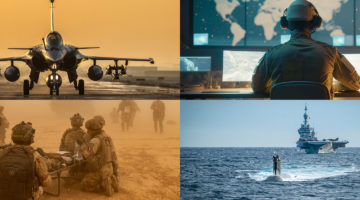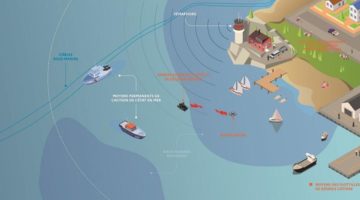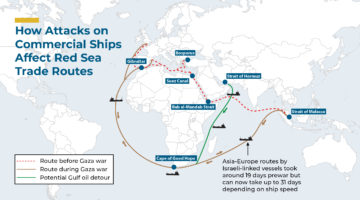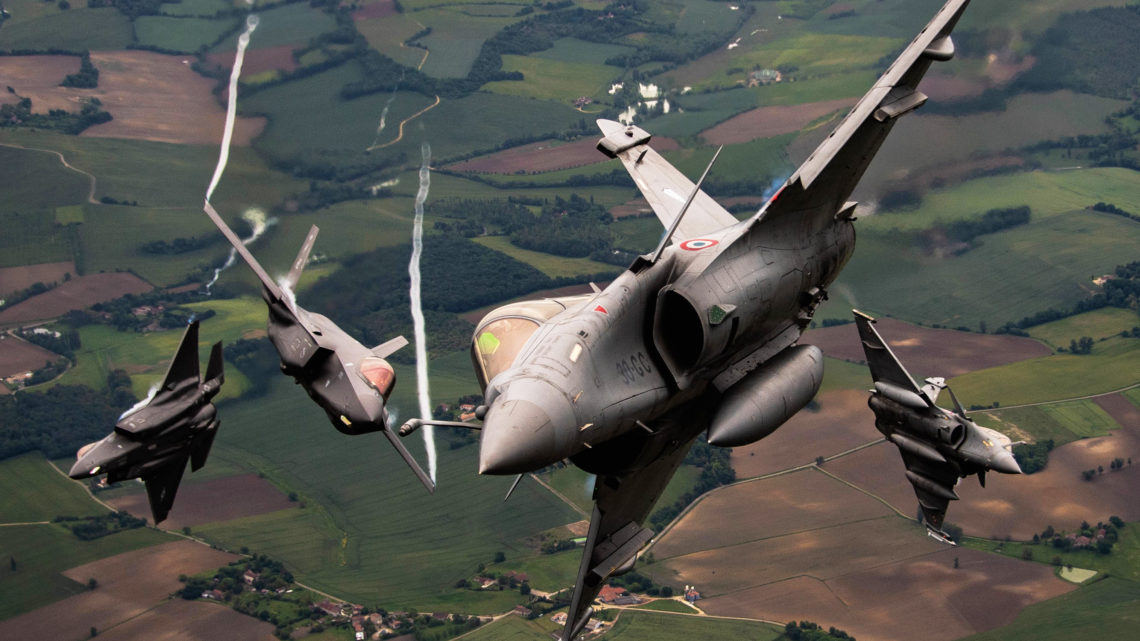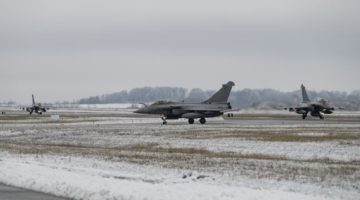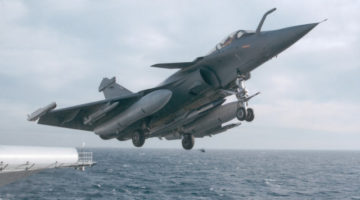By Murielle Delaporte – “Enhancing Interoperability with the F35 A Key To Future Joint Allied Operations”1
Every eighteen months US and French Air Force senior military authorities meet to discuss operations and long term requirements in a framework known as “operator engagement talks.” These discussions are generally meant, according to the official USAF description, to “share air, space, and cyberspace lessons-learned to improve interoperability and integration,” as well as “strengthen and expand alliances and partnerships.”
A few days ago, we sat down with Lt-Gen Parisot, number two in the French Air and Space Force (FASF), as he was ending his three-day visit in the United States in that capacity. An opportunity for him to highlight the strength of a century-old bilateral relationship, while identifying common challenges at a time of major international crisis and the sound of marching boots getting heavier.
“The relationship between our two air forces go back to 1917 when the very first American pilots joined ranks with the very first French pilots to fight a common enemy. Today more than ever, we celebrate the Lafayette Escadrille and no later than last July, I had the honor to present the US Chief of staff of the Air Force, general Charles Q. Brown, with the squadron’s insignia as he was visiting French Air Base 113 Saint Dizier.”

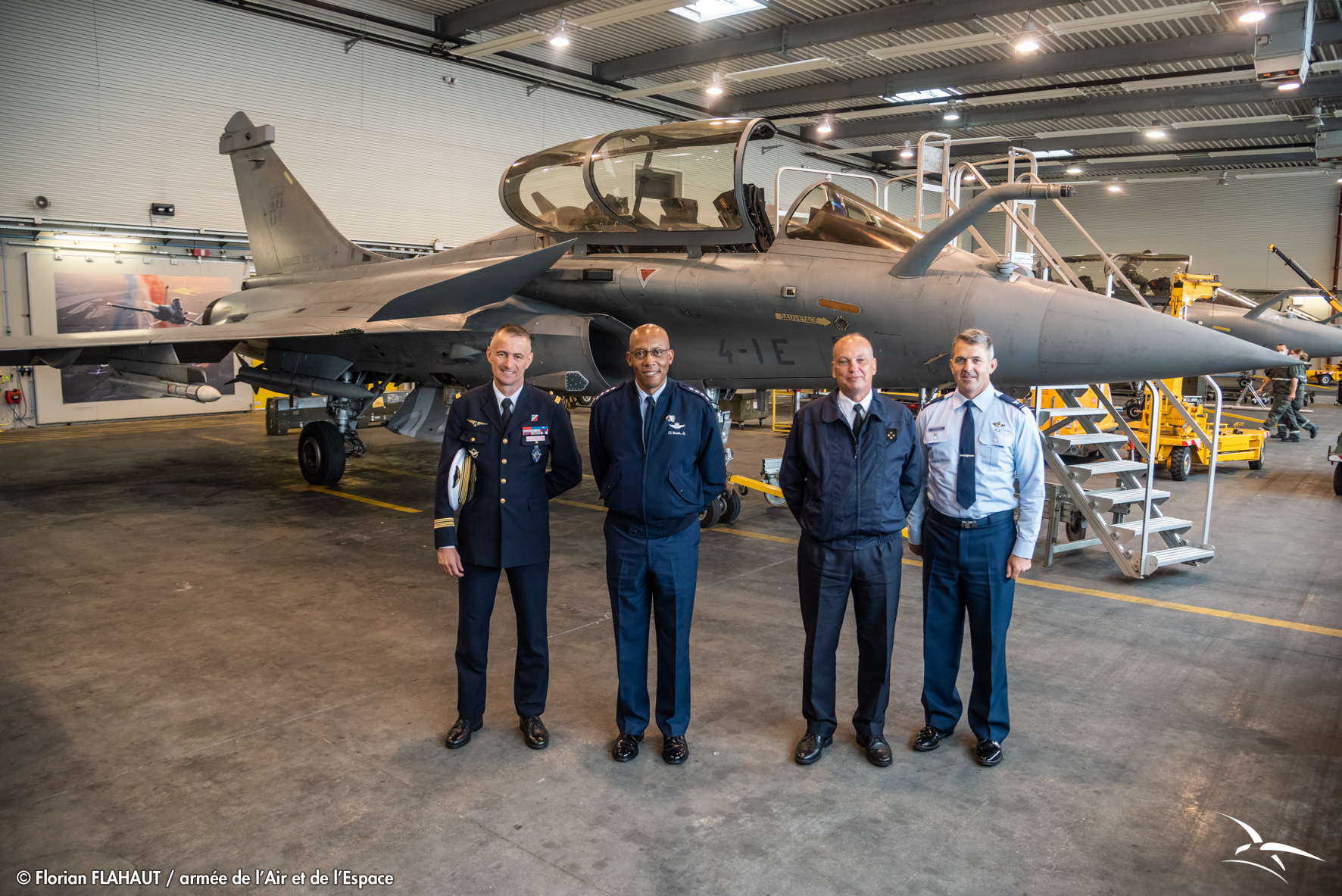
General Brown at Saint Dizier FAB © AAE (https://www.defense.gouv.fr/air/actus-air/visite-du-cemaa-americain-sur-la-base-aerienne-113)
A Mirage 2000C pilot with more than 3000 flight hours and about 80 combat missions, Parisot – call sign “Zo” – is used to working closely with his American counterparts, as he was the very first French officer to be embedded in the Pentagon when he became liaison officer to the Chief of staff of the USAF Strategic Studies Group “Checkmate” from 2008 to 2010.
That means that when he expresses concern about interoperability between the two services, it comes from experience. And that is exactly the issue he raised when talking about the F-35 and is the challenge to integrate the fifth-generation fighter with French networks.
“We would like to be able to operate in the same integrated way we did in 2018 during the raid against Syrian chemical capabilities[1]. I am not certain it is the case right now, as there are more and more F-35 squadrons within NATO and our interoperability between F-35s and Rafales is still a work in progress.”
“It is inconceivable to have a two-speed alliance separating F-35 fleets from the others and this issue of interoperability has been one of our priorities during this visit,” he explained.
Of course, the F-35 and Rafale have gone head-to-head in a number of global competitions, something Parisot acknowledged is a natural difference of agenda between operators and those focused on economic competition. “F-35s and Rafales are ending up competing for the same export markets and this can sometimes constitute a break in the way the US and French Air Forces would like to conduct joint operations,” he said.
Thankfully the light at the end of the tunnel seems now visible as the two sides are discussing a compromise that may bring to life a mutually-viable technical solution.
A Link16 user like most of its allies within NATO, France has been for the past three years a strong proponent of developing a European standard for a new military tactical data link network fully interoperable with the US. This network would naturally be different from the MADL (Multifunction Advanced Data Link) currently used by the F-35, as the focus in French procurement has been to enhance sovereign standards.
Last December Thales was awarded a procurement contract for the integration and support of SatCom aeronautic stations (Mélissa for ‘’Marché d’élaboration d’intégration et de soutien des stations satcom aéronautiques’’). The goal is to allow the FASF air assets to communicate and exchange data via a protected and hardened (against high intensity threat) link using the military constellation Syracuse IV. By 2025, these stations will be integrated to the MRTT tanker enhancing its role as the key C2 nod for FCAS (Future combat air system)[2].
As a result, the French network Parisot refers to would be another card to plug into the F-35 Communications, Navigation and Identification systems (CNI), and not require major modifications to the F-35’s internal systems. This system allows data fusion and communication (including Blue Tracking) through software-defined radio technology, therefore enhancing the level of integration among wingmen, no matter which air asset they fly[3].
“The idea is to develop an open architecture allowing to move forward and to upgrade the systems as needed without IP issues,” Parisot said. “Both our Air Forces are currently under tremendous operational pressure, and we have been able to make considerable progress, thanks to the support and open mind of our American counterparts, in particular Gen. Jeffrey Harrigian,” the commander of US Air Forces – Europe.
Another major bilateral breakthrough happened last May during Atlantic Trident, a trilateral exercise between the USAF, the RAF and the FASF which has taken place every year since 2015 in order to train for high-end air combat[4]. For the first time, that exercise took place in France – at the FAB 118 in Mont de Marsan – and it was the very first time USAF F35s flew in France and along the side of French Rafales.
“British F-35Bs also flew from the HMS Queen Elisabeth and we were able to succeed in some missions, while identifying where progress was very much needed. This is what we are trying to work out through our exchanges and future exercises.” The next Atlantic Trident is indeed planned in the UK in 2023.
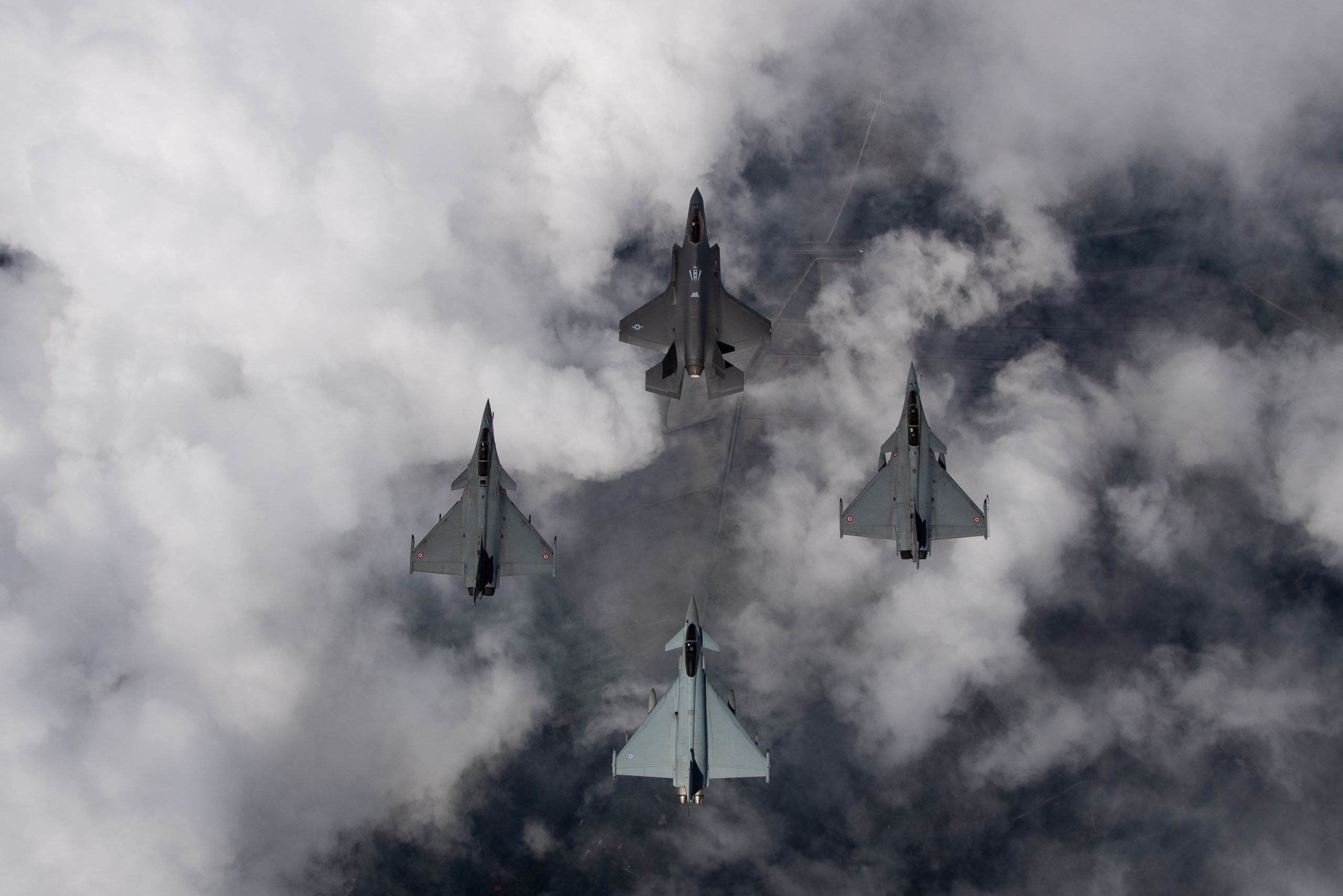
A U.S. Air Force F-35A Lightning II, two Dassault Rafales and a Royal Air Force Eurofighter Typhoon fly in formation May 19, 2021, over France. The flight was apart of the Atlantic Trident 21 exercise © U.S. Air Force photo by Staff Sgt. Alexander Cook
What follows is a condensed and translated Q & A of the rest of the interview emphasizing the French Air and Space Force main objective, i.e. recovering strategic air superiority within the next ten to fifteen years.
Speaking of exercises, how does AUKUS impact the air component of the French IndoPac strategy ?
The Heifara-Wakea exercise we conducted last summer in the Pacific[5] put a lot of stress on our aviators (with the longest flight ever performed on a Rafale, i.e. twelve hours), but we did learn a lot, especially as we were able to fly with PACAF’s F-22s in that part of the world.
This week’s meeting reinforced our common will to keep such exercises going every year, starting this summer where a similar air raid is already planned from the French metropole to New Caledonia, a collectivity of overseas France in the southwest Pacific Ocean. This time the exercise will include six Rafales instead of three. Our goal is to deploy the year after up to twenty Rafales and ten MRTT tankers, which basically represents an aircraft carrier.
The strategic objective is to send a clear message to our potential adversaries, such as China, demonstrating our ability to deploy substantial means within a 20,000 kilometer range in 48 hours. A show of force which demonstrates not only the variety of missions the FASF can conduct, but also its ability to reinforce a coalition wherever it may be in a very short time.
In addition such exercises allow the French Air and Space Force to reinforce its partnerships with Rafale end-users along the way: the “Rafale pearl necklace” which is being built with Indonesia being the very last addition to Egypt, Qatar, India, UAE, Greece and Croatia.
Is such a show of force part of the high spectrum training necessary today?
Indeed the ability to conduct such long-range raids does position the French Air and Space Force as a serious player in the high intensity realm in terms of credibility and deterrence.
We all enjoyed a certain strategic comfort in terms of air dominance in the past thirty years and we know these days are over. France however never lost its first entry capability as its strategic air forces (FAS for “Forces aériennes stratégiques”) never stopped training. Such exercises are today more publicized for deterrence purpose (e.g. regular Poker exercises, as well as, earlier this month, the Shikra mission which mixed strategic nuclear air forces and high intensity conflict scenarii in La Réunion and Djibouti).
The FAS capabilities have been actually shining throughout and uplifting our entire Air and Space Force in terms of know how. As an example, a very large percentage of the FAS crews have flown their fighters for more than ten hours, one of the criteria for high intensity warfare.
Being a FAS “job,” high intensity has therefore been remaining in the FASF DNA as much as – if not more than – counter-terrorism. We also train a lot with our last generation Meteor missile which does transform air combat and was actually part of the Heifara-Wakea exercise.
Besides the show of force, we are also currently focusing on reinforcing our special forces component and we are working closely with Airbus to develop a Special Force standard for the A400M as our traditional C160 Transall is retiring in a few weeks after sixty years of loyal services. The ability for the A400M to refuel helicopters should also be certified this year, which will provide an interesting operational capability for the Special forces.
Among our weak points, we need however to fine tune our tactics in a peer-to-peer environment by investing more in our simulation capabilities, including a mix of live and virtual exercises.
And of course, we need to take into consideration our ability to sustain the fight by enhancing our ammunition and missiles stocks to limit attrition.
Our conversations this week once again stressed the convergence between our two Air Forces in terms of concepts and procurement priorities. Even though the FASF cannot obviously compare to the USAF in terms of its size and volume, we do envision high intensity training in a similar manner whether talking about what simulation or AI can bring to the party, or about the future missions of our respective NGAD and NGWS/NGF programs.
France is technologically behind the United States in some areas such as Joint All Domain Command and Control capabilities (JADC2), but the vision for needed specs is the same and the determination to close the gap is genuine.
The French armed forces are working very hard on joint connectivity between the French Air and space Force, the French Navy and the French Army through a program called “Contact.” The French Air and Space Force is planning to reach a first milestone by 2025 to connect its air assets – Rafales, MRTTs, A400Ms, but also the future Euromales – via a network called “Connect Aero.”
Space has been officially added to the French Air Force since September 2020 and our newly created Toulouse-based Space Command (CDE for “Commandement de l’espace”) – which is also the new NATO Center of Excellence for Space[6] – is very similar to the US Space Command. We do share data in order to enhance our common Space Situational Awareness (SSA) and we have been developing new capabilities with good quality captors such as Syracuse IV (SatCom) and CERES (ELINT) allowing us to bring more data to the party bilaterally and through NATO, as we do right now for instance as the Ukraine crisis keeps intensifying.
As far as the Ukraine events are concerned, such SA and data-sharing capability comes in addition to the flights we do on a regular basis above Romania and the Black Sea with our AWACS, our Gabriel C160 SIGINT [Editor’s note : it is to be phased out this year and soon to be replaced by the Archange Falcon 8X], as well as our Mirage 2000D equipped with ASTAC pods.
The French Air and Space Force also traditionally participates in the NATO Baltic Air policing mission since 2014 and its next rotation will run from April to July in Latvia and will involve four Mirage 2000-5.
In order to reach air superiority within the next decade, what are the challenges facing the FASF as far as procurement goes ?
The good news is that the current program law has been respected and our fleet is in the process of being renewed : KC135s with MRTTs ; C160s with A400Ms ; Mirage 2000s with Rafales…
The bad news is that our fleet is being renewed… all at once and with a high operational tempo. Such a critical phase creates a vulnerability as it requires a huge optimization of the technical potential, new infrastructure and new types of training. For instance as our Mirage 2000s will retire this summer from Orange AB, we need to train more pilots ab initio on Rafale, which fleet will only start surging in 2024.
If we were very happy to export Rafales, we technically “lost” 24 aircrafts since some of these exports were pulled out from our own fleet, i.e. 1/4th of our own force, which means less technical potential, which means less flight hours. We are indeed struggling in keeping the NATO required levels with only in average 160 flight hours for fighters, 200 for transport and about 160 for helicopters. It is therefore absolutely crucial for the FASF that the program law is implemented as planned after the elections when a 3 billion euros increase should occur each year between 2023 and 2025. Otherwise we shall be faced with painful choices at a time of increased threats.
—-
Footnotes
[1] Referred in France as the Hamilton Operation >>> https://breakingdefense.com/2018/05/french-quick-reaction-force-key-to-syrian-missile-strikes/
[3] https://sldinfo.com/2019/12/the-f-35-cni-evolution-and-evolving-the-combat-force/
[4] See >>> https://breakingdefense.com/2015/12/f-22-typhoon-rafale-lessons-from-the-trilateral-wargame/
[5] https://breakingdefense.com/2021/07/inside-the-laboratory-of-premieres-for-french-air-power/
[6] See : https://breakingdefense.com/2021/04/asterx-2021-french-space-forces-reach-for-higher-orbit/
Photo 1 © Two U.S. Air Force F-35A Lightning IIs assigned to the 4th Fighter Squadron, Hill Air Force Base, Utah, and two Dassault Rafales assigned to the 1/4 Gascogne Fighter Squadron, 113 Saint-Dizier-Robinson air base, France, break formation during flight over France. The flight was apart of the Atlantic Trident 21 exercise, U.S. Air Force photo by Staff Sgt. Alexander Cook, Mont de Marsan, May 18,2021
1 A version of this interview was first published by the US website Breaking Defense >>> https://breakingdefense.com/2022/03/french-air-force-no-2-pushing-for-greater-rafale-jsf-interoperability/

